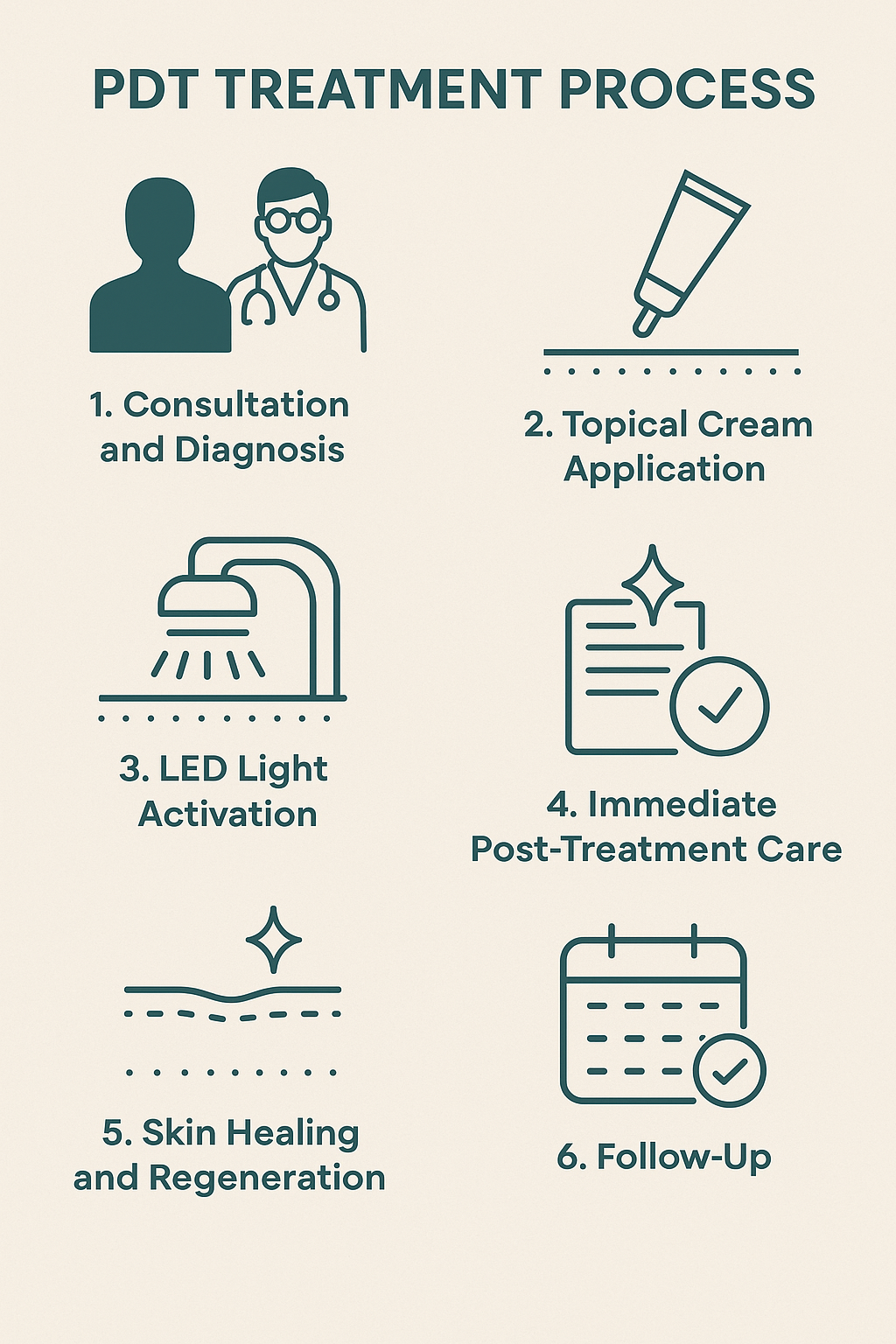Photodynamic Therapy: Non-Surgical Skin Cancer Treatment Explained
At Shade Skin in Perth, we believe in offering cutting-edge, non-invasive treatments for skin cancer and sun-damaged skin. One such option is Photodynamic Therapy (PDT) - a highly targeted, non-surgical treatment used to manage certain precancerous and non-melanoma skin cancers.
Below, we’ll explain how PDT works, who it’s suitable for, its benefits, what to expect before and after treatment, and why it’s becoming a popular alternative for patients in Western Australia.
What Is Photodynamic Therapy?
Photodynamic Therapy is a two-step medical treatment that uses a light-sensitive cream (photosensitising agent) and a specific wavelength of LED light to selectively destroy abnormal skin cells. It is most commonly used to treat:
Solar (actinic) keratoses (AKs) – precancerous sunspots caused by long-term UV exposure
Certain types of keratinocyte (non-melanoma) skin cancer – particularly superficial forms
PDT uses a combination of a topical cream and light exposure to activate a cell-destroying reaction in abnormal tissue.
How PDT Works
PDT uses a combination of a topical cream and light exposure to activate a cell-destroying reaction in abnormal tissue. The process is highly targeted, helping to preserve surrounding healthy skin.
A typical PDT session involves:
1. Application of Photosensitising Cream
A specialised cream containing 5-aminolevulinic acid (5-ALA) is applied to the treatment area. This cream is selectively absorbed by abnormal cells during a 1–3 hour incubation period.
2. Light Activation
After incubation, a specific wavelength LED light is applied. This activates the cream, generating reactive oxygen species that damage or destroy abnormal and precancerous cells.
3. Targeted Cell Destruction
The body then naturally removes the destroyed cells, allowing healthy tissue to regenerate over the treated area.
Who Is an Ideal Candidate for PDT?
PDT is best suited for patients with superficial or early-stage lesions, especially in areas where surgery may lead to scarring or cosmetic concerns. It is not appropriate for deeper or more aggressive skin cancers.
Ideal candidates may include:
Individuals with actinic keratoses (AKs) on the face, scalp, hands or chest
Patients with widespread sun-damaged skin that requires field treatment
Those diagnosed with superficial basal cell carcinoma (BCC) in cosmetically sensitive areas
People seeking an alternative to excision, cryotherapy, or topical therapies that involve longer downtime
Patients looking for a minimally invasive treatment with little disruption to daily life
Key Advantages of Photodynamic Therapy
Compared to surgery or freezing techniques, PDT offers a range of benefits that make it a compelling option for many patients.
Key advantages include:
Non-invasive – no cutting or sutures required
Efficient treatment – large areas can be treated in a single session
Faster recovery – most people return to normal activities within 7–10 days
Repeatable – safe to re-treat the same site if necessary
Superior cosmetic outcomes – even skin tone and texture post-treatment, with less risk of scarring or pigment changes compared to cryotherapy, electrocautery or surgery
What to Expect Before, During and After PDT Treatment
Being well-prepared can improve treatment comfort and healing outcomes. At Shade Skin, we provide clear, evidence-based instructions at every stage.
Two Weeks Prior to Treatment
Begin your 2-week skin preparation, as discussed at your Full Skin Check
Use Allmedic cleanser to wash the treatment area twice daily
Continue normal sun protection practices and minimise direct UV exposure
On the Day of Treatment
If prone to cold sores and receiving facial PDT, take an over-the-counter antiviral such as famciclovir on the day
You may also take paracetamol or ibuprofen 30 minutes prior to the light phase, and one antihistamine (e.g. Telfast) to reduce inflammation
Avoid vigorous exercise or sweating for five days post-treatment
Dress in or bring protective clothing (wide-brimmed hat, sunglasses, long sleeves, gloves) to shield the treated area
Plan to remain in clinic for the full 60–90 minute incubation period (bring snacks if needed). In some cases, you may return home wearing protective gear
The light phase typically lasts 10–20 minutes. A cooling fan may be provided for comfort
Photodynamic Therapy Infographic
After Treatment
Book a follow-up appointment with your treating doctor for Day 7
Your skin will be extremely light-sensitive for 48 hours—strict sun avoidance is critical
Apply Cicaplast or soothing moisturiser 3–4 times daily (refrigerated for added relief)
Redness, swelling, and peeling similar to sunburn is expected
Avoid pools, spas, and exfoliants for several days
Most patients fully recover within 7 to 14 days
How Much Does PDT Cost?
PDT is a non-surgical treatment used to target sun-damaged skin, solar keratoses, and certain non-melanoma skin cancers. At Shade Skin, pricing is based on the size of the treatment area:
Small area: $749
Large area: $849
Your doctor will advise on the appropriate treatment area during your full skin check and consultation. Medicare rebates may apply depending on your clinical diagnosis and referral.
Is PDT Available in Perth?
Yes. At Shade Skin in West Perth, we offer Photodynamic Therapy as part of our advanced non-surgical treatment options for sun-damaged and cancer-prone skin. Our experienced team of doctors and nurses will assess your condition and determine whether PDT is the most appropriate treatment.
If you have concerns about actinic keratoses, suspicious sunspots, or superficial skin cancers, we encourage you to book a full skin check. Early intervention can lead to better outcomes and PDT may be the ideal solution.
Written by Dr Emily Alfonsi
MBBS, FRACGP, DRANZCOG
Medical Director, Shade Skin
Dr Emily is a skin cancer doctor with advanced training in diagnosis and treatment. She has personally detected and treated hundreds of skin cancers and is passionate about early intervention and patient education.


